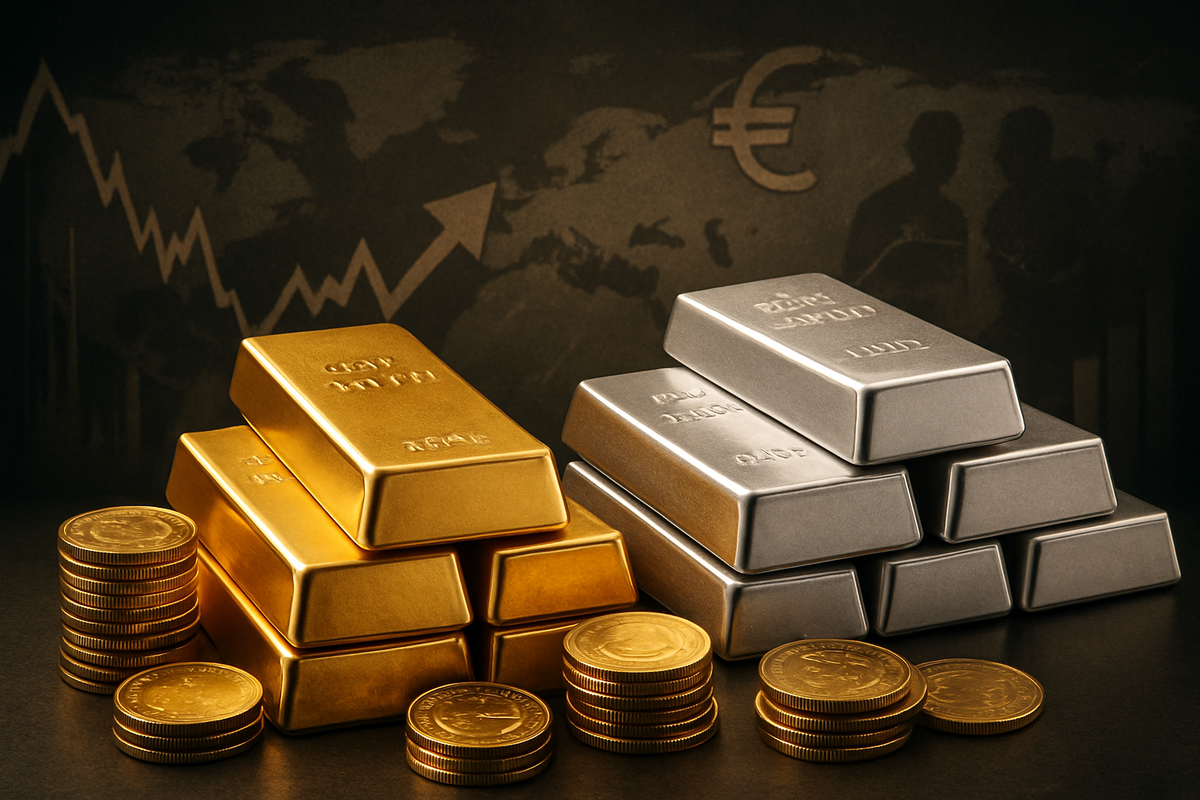
As of November 4, 2025, the global financial markets are witnessing a monumental surge in precious metal prices, with gold breaching the $4,100 per ounce mark and silver escalating beyond $51. This historic rally, unfolding throughout the year, signifies a profound shift in investor sentiment, driven by a complex interplay of persistent inflation, looming recession fears, and an increasingly volatile geopolitical landscape. The unprecedented valuations underscore a growing global appetite for safe-haven assets, as traditional financial instruments grapple with uncertainty and central banks globally redefine their reserve strategies.
The Perfect Storm: Unpacking the 2025 Precious Metals Rally
The dramatic ascent of gold and silver prices in 2025 is not an isolated event but the culmination of several powerful market drivers creating a "perfect storm" for precious metals. Gold's journey past $4,100 per ounce and silver's climb above $51 mark significant milestones, reflecting deep-seated anxieties within the global economy and financial system.
A primary catalyst has been the persistent inflation that has plagued economies, eroding the purchasing power of fiat currencies and pushing investors towards gold and silver as traditional hedges. Compounding this, growing fears of a global recession – evidenced by weaker-than-expected economic data, cooling labor markets, and a late-2025 U.S. government shutdown – have further driven capital into safe-haven assets. The weakening U.S. Dollar Index, hovering near multi-month lows, has also made dollar-denominated precious metals more attractive to international buyers.
Geopolitical instability has played a critical role, with ongoing conflicts and tensions fueling uncertainty. The protracted Russia-Ukraine conflict, persistent instability in the Middle East, and escalating US-China trade wars (including new tariffs implemented by President Donald Trump in February 2025) have all contributed to a significant "conflict premium" for gold and silver. Investors are increasingly seeking tangible assets to preserve wealth amidst a fractured global political landscape.
Crucially, monetary policy shifts have provided substantial tailwinds. The Federal Reserve implemented two 25-basis-point rate cuts in September and October 2025, bringing the federal funds rate to a target range of 3.75% to 4.0%. This dovish pivot, coupled with the halting of quantitative tightening, has reduced the opportunity cost of holding non-yielding assets. Furthermore, central banks globally have been on an unprecedented gold-buying spree, accumulating over 1,000 tonnes annually for three consecutive years, including a strong showing in 2025. This structural shift reflects a deliberate diversification away from the U.S. dollar, providing robust, long-term support for gold prices.
Corporate Fortunes: Winners and Losers in the Metals Boom
The historic gold and silver rally of 2025 is creating a clear divide between winners and losers across various public company sectors, profoundly impacting their profitability, operational strategies, and market valuations.
Mining companies stand as the primary beneficiaries. Higher metal prices directly translate into increased revenues and expanded profit margins due to operational leverage. This surge incentivizes greater investment in exploration and production, making previously uneconomical deposits viable. Companies like Newmont (NYSE: NEM), the world's largest gold miner, and Barrick Gold (NYSE: GOLD) are poised for substantial profit boosts. Silver miners such as Pan American Silver (NASDAQ: PAAS) and Hecla Mining Company (NYSE: HL) are also experiencing enhanced profitability. Precious metals streaming companies like Wheaton Precious Metals Corp. (NYSE: WPM) benefit from margin expansion without direct mining costs, as they purchase future production at predetermined prices.
Conversely, jewelry retailers are facing significant headwinds. Gold and silver are their core raw materials, so soaring prices directly increase input costs and inventory expenses. This typically leads to higher retail prices, which in turn dampens consumer demand. Major players like Signet Jewelers Limited (NYSE: SIG), parent to Kay Jewelers and Zales, are likely to experience reduced sales volumes and squeezed profit margins as consumers either postpone purchases or opt for less expensive alternatives.
Industrial users of gold and silver are also grappling with rising costs. These metals are indispensable in sectors like electronics, solar panels, and medical devices due to their unique properties. Manufacturers of smartphones and computers, such as Apple (NASDAQ: AAPL) and Samsung Electronics (KRX: 005930), and chipmakers like Intel (NASDAQ: INTC) and NVIDIA (NASDAQ: NVDA), face increased material expenses for the gold used in their components. Similarly, solar panel manufacturers like First Solar (NASDAQ: FSLR) and JinkoSolar (NYSE: JKS) are seeing higher input costs for silver, a critical component in photovoltaic cells. These industries are compelled to explore cost-effective alternatives and enhance recycling efforts.
Financial institutions are experiencing a mixed impact. Those actively involved in commodity trading, precious metals derivatives, or physical bullion sales, such as major investment banks like JPMorgan Chase (NYSE: JPM) and Goldman Sachs (NYSE: GS), can generate significant profits. Investment firms offering gold-backed Exchange-Traded Funds (ETFs) are seeing increased demand. However, commercial banks with extensive lending to industrial users or jewelry retailers might face indirect risks if their clients struggle. Hedge funds with short positions in precious metals would, of course, incur losses.
A New Era: Wider Significance and Historical Context
The 2025 gold and silver rally is more than just a market event; it signifies a profound re-evaluation of global financial architecture and asset allocation strategies, echoing historical periods of economic and geopolitical stress.
This rally underscores a broader trend of eroding confidence in traditional fiat currencies and government bonds, particularly amidst persistent inflation and escalating national debt. Investors are actively seeking tangible assets as a hedge against currency debasement and market volatility. This shift is diverting capital from traditional assets, impacting bond markets and equity valuations.
The accelerated accumulation of gold by central banks, especially from non-Western and emerging economies, is a critical development. This trend signals a deliberate move towards greater financial sovereignty and a diversification away from an over-reliance on the U.S. dollar, fundamentally altering global reserve management. This institutional buying effectively removes metal from circulation, contributing to structural supply-demand imbalances.
For other precious metals, a strong gold and silver market can create a "pull-up" effect. Platinum and palladium, also considered safe havens, may see renewed investor interest, particularly given supply fragilities and rising industrial demand. For silver, its dual role as an industrial metal means its rally impacts industries like electronics and solar energy, pushing them to secure supply chains and implement hedging strategies against input cost volatility.
From a regulatory and policy standpoint, the rally intensifies scrutiny on monetary policy, with central bank decisions on interest rates and quantitative easing being closely watched. There could be increased governmental attention on gold flows, potential new taxation policies, and discussions around national control over strategic resources, reshaping global supply chains and trade dynamics.
Historically, this rally draws parallels to the 1970s gold bull market, which saw prices surge by 2,300% driven by double-digit inflation, expanding budget deficits, geopolitical shocks, and a crisis of confidence in fiat currencies. Similarly, the 2001-2011 rally and surges during the 2008 Global Financial Crisis and the COVID-19 pandemic demonstrated gold's role as a safe haven during economic uncertainty. Silver, known for its greater volatility, often outperforms gold in the middle to later stages of bull markets, especially when industrial demand and inflation expectations rise, leading to a compression of the gold-silver ratio. The current rally firmly places precious metals at the center of global financial stability discussions.
The Road Ahead: What Comes Next for Precious Metals
Following a year of historic gains, market participants are keenly focused on the future trajectory of gold and silver. While short-term volatility and consolidation are likely, the long-term outlook remains predominantly bullish, supported by enduring fundamental drivers.
In the short-term (late 2025 - early 2026), expect continued two-way volatility as investors engage in profit-taking and assess how much of the current bullish drivers have been priced in. Gold may enter a "cooling phase" with sideways trading, albeit with an upward bias. The Federal Reserve's future policy decisions, particularly further rate cuts, will remain a primary catalyst. Weaker U.S. economic data could reinforce dovish expectations, benefiting gold. Conversely, a hawkish shift or stronger economic data could present headwinds. Geopolitical developments will continue to influence safe-haven demand, and the U.S. dollar's strength will impact international buying power. Silver, potentially undervalued relative to gold, could see significant upside driven by its strong industrial demand in green energy and its historical tendency to outperform gold in later stages of bull markets. Central bank gold buying is also expected to continue providing strong price support.
The long-term outlook (2026 and beyond) for gold and silver is largely bullish, with many analysts forecasting gold prices between $4,000 and $5,000 per ounce by mid-2026 and potentially higher by 2028. Even if the pace of gains moderates, gold is expected to establish a new, elevated baseline significantly above historical averages. Structural demand drivers such as persistent global debt, negative real interest rates, currency debasement, geopolitical fragmentation, and central bank diversification away from the U.S. dollar will continue to underpin higher prices. Silver's dual role and increasing industrial use, coupled with projected supply shortages, provide robust long-term demand fundamentals. The increasing importance of physical exchanges over paper trading venues, driven by liquidity concerns, could lead to more accurate, physically-driven price discovery.
For investors, strategic pivots involve a continued focus on diversification across asset classes, and within precious metals (gold, silver, platinum, palladium). Dollar-cost averaging and accumulating on meaningful dips are advised for long-term positions. Balancing physical bullion with paper assets like ETFs and mining stocks, tailored to individual risk appetites, is also crucial. Investors should monitor market developments closely and avoid emotional decisions based on short-term fluctuations. Investing in well-researched mining stocks can offer leveraged exposure to the rally.
Opportunities include the potential for silver to significantly outperform gold due to its relative undervaluation and strong industrial demand. Gold's reclassification as a Tier 1 high-quality liquid asset by Basel III rules in July 2025 also enhances its attractiveness to commercial banks and institutional investors, potentially driving further demand. Challenges include short-term price volatility, the lack of income from physical metals, and the costs associated with storage and security.
Potential scenarios range from a sustained bull run (high probability) where gold and silver continue their ascent driven by current macroeconomic and geopolitical forces, to a consolidation and gradual ascent (moderate probability) as the market digests the recent gains, or a significant correction (lower probability) triggered by unexpected hawkish central bank policies or a de-escalation of global tensions. However, even in a correction, the strong underlying structural drivers suggest a recovery from a higher baseline.
Conclusion: A New Golden Era Unfolds
The historic gold and silver price rally of 2025 marks a pivotal moment in financial history, underscoring the enduring significance of precious metals as anchors of value in an increasingly uncertain world. The confluence of persistent inflation, recessionary fears, escalating geopolitical tensions, and a fundamental shift in central bank monetary policies has propelled gold beyond $4,100 per ounce and silver above $51, establishing a new, elevated baseline for these vital commodities.
The market moving forward is characterized by a long-term bullish outlook, albeit with an expectation of short-term volatility and consolidation. The structural drivers—including continued central bank gold accumulation, negative real interest rates, and the global re-evaluation of reserve assets—are firmly in place to support higher prices. Silver, with its dual role as a monetary and industrial metal, holds particular promise for outperformance, driven by increasing demand from green energy technologies and its relative undervaluation.
This event is not merely a cyclical market surge but a reflection of deep-seated structural changes in the global economic and geopolitical landscape. It influences everything from mining operations and industrial supply chains to international monetary policies and individual investor strategies. The lasting impact will likely be a redefinition of precious metals' role in diversified portfolios and a continued shift away from an over-reliance on traditional fiat currencies.
Investors should remain vigilant, closely monitoring Federal Reserve policy decisions, U.S. economic data (especially labor market indicators), evolving geopolitical developments, the strength of the U.S. dollar, and the ongoing trends in central bank gold buying. The gold-silver ratio will also be a key indicator for potential shifts in relative value. While the path ahead may not be without its bumps, the current environment suggests that precious metals are poised to maintain their luster as essential components of wealth preservation and growth in the coming months and years.
This content is intended for informational purposes only and is not financial advice





